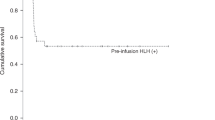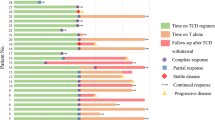Abstract
Langerhans cell histiocytosis (LCH) that is refractory to conventional chemotherapy has a poor outcome. Hematopoietic stem cell transplanta tion (SCT) is a promising approach for refractory LCH because of its immunomodulatory effect. In this study, the outcomes of children with refractory LCH undergoing SCT in Japan were analyzed. Between November 1995 and March 2007, 15 children younger than 15 years (9 males, 6 females) with refractory LCH underwent SCT. The patients’ median age at diagnosis was 8 months (range, 28 days to 28 months), and all had failed conventional chemotherapy. The median age at SCT was 23 months (range, 13–178 months). Nine had risk organ involvement at diagnosis, including liver (n=6), spleen (n=5), lung (n=5), and/or hematopoietic system (n=4). For SCT, a myeloablative regimen was used for 10 patients, and a reduced-intensity conditioning regimen (RIC) was used for five. The donor source varied among the patients, but allogeneic cord blood was primarily used (n=10). Subsequently, 11 of 15 patients have survived with no evidence of disease, with a 10-year overall survival (OS) rate (median±standard error) of 73.3±11.4%. The 10-year OS rate of nine patients with risk organ involvement at diagnosis was 55.6±16.6%, whereas six without risk organ involvement have all survived with no evidence of disease (P=0.07). These results indicate that SCT is promising as a salvage approach for children with refractory LCH.
This is a preview of subscription content, access via your institution
Access options
Subscribe to this journal
Receive 12 print issues and online access
$259.00 per year
only $21.58 per issue
Buy this article
- Purchase on Springer Link
- Instant access to full article PDF
Prices may be subject to local taxes which are calculated during checkout

Similar content being viewed by others
References
McClain KL, Natkunam Y, Swerdlow SH . Atypical cellular disorders. Hematology Am Soc Hematol Educ Program 2004, 283–296.
Stephan JL . Histiocytoses. Eur J Pediatr 1995; 154: 600–609.
Henter JI, Tondini C, Pritchard J . Histiocyte disorders. Crit Rev Oncol Hematol 2004; 50: 157–174.
Minkov M, Grois N, Heitger A, Pötschger U, Westermeier T, Gadner H, DAL-HX Study Group. Response to initial treatment of multisystem Langerhans cell histiocytosis: an important prognostic indicator. Med Pediatr Oncol 2002; 39: 581–585.
Gadner H, Grois N, Arico M, Broadbent V, Ceci A, Jakobson A et al. A randomized trial of treatment for multisystem Langerhans’ cell histiocytosis. J Pediatr 2001; 138: 728–734.
Gadner H, Grois N, Pötschger U, Minkov M, Aricò M, Braier J et al. Improved outcome in multisystem Langerhans cell histiocytosis is associated with therapy intensification. Blood 2008; 111: 2556–2562.
A multicentre retrospective survey of Langerhans’ cell histiocytosis: 348 cases observed between 1983 and 1993. The French Langerhans’ Cell Histiocytosis Study Group. Arch Dis Child 1996; 75: 17–24.
Morimoto A, Ikushima S, Kinugawa N, Ishii E, Kohdera U, Sako M et al. Improved outcome in the treatment of pediatric multifocal Langerhans cell histiocytosis: results from the Japan Langerhans Cell Histiocytosis Study Group-96 protocol study. Cancer 2006; 107: 613–619.
Bernard F, Thomas C, Bertrand Y, Munzer M, Landman Parker J, Ouache M et al. Multi-centre pilot study of 2-chlorodeoxyadenosine and cytosine arabinoside combined chemotherapy in refractory Langerhans cell histiocytosis with haematological dysfunction. Eur J Cancer 2005; 41: 2682–2689.
Steiner M, Matthes-Martin S, Attarbaschi A, Minkov M, Grois N, Unger E et al. Improved outcome of treatment-resistant high-risk Langerhans cell histiocytosis after allogeneic stem cell transplantation with reduced-intensity conditioning. Bone Marrow Transplant 2005; 36: 215–225.
Caselli D, Aricò M, EBMT Paediatric Working Party. The role of BMT in childhood histiocytoses. Bone Marrow Transplant 2008; 41: S8–S13.
Kaplan EL, Meier P . Nonparametric estimation for incomplete observations. J Am Stat Assoc 1958; 53: 457–481.
Cancer Therapy Evaluation Program, Common Terminology Criteria for Adverse Events, Version 3.0, DCTD, NCI, NIH, DHHS March 31, 2003 (http://ctep.cancer.gov), Publish Date: December 12, 2003.
Schag CC, Heinrich RL, Ganz PA . Karnofsky performance status revisited: reliability, validity, and guidelines. J Clin Oncol 1984; 2: 187–193.
Ringden O, Ahstrom L, Lonnqvist B, Båryd I, Svedmyr E, Gahrton G . Allogeneic bone marrow transplantation in a patient with chemotherapy-resistant progressive histiocytosis X. N Engl J Med 1987; 316: 733–735.
Kinugawa N, Imashuku S, Hirota Y, Yamada K, Yamamoto A, Akazai A et al. Hematopoietic stem cell transplantation (HSCT) for Langerhans cell histiocytosis (LCH) in Japan. Bone Marrow Transplant 1999; 24: 935–938.
Steiner M, Matthes-Martin S, Attarbaschi A, Lawitschka A, Minkov M, Mittheisz E et al. Importance of allogeneic T-cells for disease control after stem cell transplantation for high-risk Langerhans cell histiocytosis. Haematologica 2007; 92: e3–e4.
Acknowledgements
We thank the following for providing information on their patients: Hama A (Nagoya University), Matsubayashi T (Seirei Hamamatsu General Hospital), Hayakawa A (Kobe University), Osugi Y (Osaka General Medical Center), Ida K (The University of Tokyo), Koga Y (Kyushu University), Ueyama J (Tottori University), Yoshida M (Asahikawa Medical College), Yamamoto S (Showa University Fujigaoka Hospital), and all JSPH members. We also thank Takahashi H (University of Tsukuba) for helpful discussion regarding the statistical analysis. This work was supported by a Grant for Research on Measures for Intractable Diseases from the Ministry of Health, Labor and Welfare, Japan.
Author information
Authors and Affiliations
Corresponding author
Ethics declarations
Competing interests
The authors declare no conflict of interest.
Rights and permissions
About this article
Cite this article
Kudo, K., Ohga, S., Morimoto, A. et al. Improved outcome of refractory Langerhans cell histiocytosis in children with hematopoietic stem cell transplantation in Japan. Bone Marrow Transplant 45, 901–906 (2010). https://doi.org/10.1038/bmt.2009.245
Received:
Revised:
Accepted:
Published:
Issue Date:
DOI: https://doi.org/10.1038/bmt.2009.245
Keywords
This article is cited by
-
Nationwide retrospective review of hematopoietic stem cell transplantation in children with refractory Langerhans cell histiocytosis
International Journal of Hematology (2020)
-
Intensified and prolonged therapy comprising cytarabine, vincristine and prednisolone improves outcome in patients with multisystem Langerhans cell histiocytosis: results of the Japan Langerhans Cell Histiocytosis Study Group-02 Protocol Study
International Journal of Hematology (2016)
-
Outcome of pediatric patients with Langerhans cell histiocytosis treated with 2 chlorodeoxyadenosine: a nationwide survey in Japan
International Journal of Hematology (2010)



